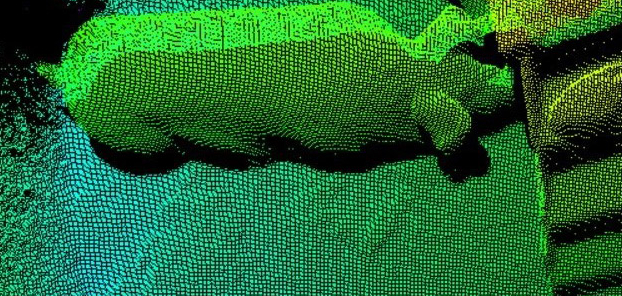A high-tech system involving 3D cameras could help UK farmers spot the early warning signs of tail biting in pigs – a health and welfare concern in affected pigs and an economic concern for industry.
New research by Scotland’s Rural College (SRUC) has revealed that pigs hold their tails down against their body when tail biting is about to begin. Experiments saw 3D cameras placed above feeders to automatically measure whether their tails were up and curly, or held down.
The research was carried out using 23 groups of weaner-grower pigs which were regularly scored for any signs of tail injury. The animals were closely monitored and tail biting was stopped as soon as an outbreak was detected.
Outbreaks of tail biting have no single cause – there are a number of contributory factors that could include elements of the pig’s genetics, nutrition, environment and management. Outbreaks can occur unpredictably and quickly spread. Tail docking can be used as a measure to control tail biting, however this is no longer seen as an acceptable routine solution to prevent against outbreaks.
The research, which has been published in the scientific journal PLOS ONE, was the result of a collaboration between SRUC animal behaviour and welfare experts, Scottish farm technology company Innovent Technology Ltd, pig supply chain partners including feed company Harbro and Sainsbury’s supermarkets, and the Agricultural Engineering Precision Innovation Centre (Agri-EPI).
Lead author Dr Rick D’Eath from SRUC said: “Tail biting results in pain and sickness for bitten pigs and severe economic losses for farmers as infection through tail wounds results in abattoir condemnation of meat. This condemnation alone can cost a producer up to 1 per cent of the carcase value and a loss for the processer of 1 per cent of saleable carcase from the pig.
“There are also unquantified on-farm costs as a result of the increased labour and veterinary treatments resulting from an outbreak. Tail docking of piglets is partly effective at reducing tail biting in later life, but is seen as an undesirable mutilation and its routine use is banned in the EU.
“This research has achieved everything we hoped for. We can automatically measure tail posture, and we’ve proved it can act as an early warning of tail biting. The challenge for us now is to develop this promising technology into a robust on-farm early warning system that works on any pig farm.”
This ‘proof of concept’ will now be developed in a follow-on Innovate UK-funded project called “TailTech”, which will collect data from more diverse pig farms and develop and test a prototype early warning system. It strengthens the consortium with additional pig supply chain partners: pig breeders JSR Genetics, engineers David Ritchie Ltd, pig vets Garth Pig Practice and farmers’ co-operative Scottish Pig Producers.
Dave Stephenson, head of Pig and Poultry at Harbro, said: “TailTech is another example of a key initiative from the British pig industry designed to drive higher welfare standards on farm.
“We’ve been delighted to partner fellow organisations from across the supply chain in seizing the vast opportunities that technology can bring to improve conditions for the animals we feed on a daily basis.”
Grant Walling, director of science and technology at JSR Genetics, said: “We recognise that tail biting impacts on animal welfare, farm productivity and pork quality. Any tool that can help reduce or eradicate the problem is a benefit to the whole supply chain.
“This technology has the potential to predict future victims so offers opportunities to update and include information within our selection strategies to reduce the incidence of tail-biting in future generations.”
Innovent Technology Ltd already produces a camera-based pig weighing system Qscan (sold internationally through SKOV as ProGrow), and the tail-biting detection system will be developed as an add-on to that technology.




